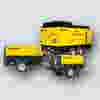What are you using it for?
Select the correct air compressor type for the application you are using it for, you can read more about the different compressed air applications here.
Piston or screw, oil-free or oil-lubricated, regulated speed or not, the latest drive technology or a proven principle? When it comes to purchasing an air compressor or upgrading an existing compressor station plant, there are many options you can choose. Oil-free compressors for example are used in food packaging where the air is in direct contact with the process it serves & so must be completely pure.
What CFM (or what airflow requirement) do I have?
To power a typical air tool in a factory workshop would take say 4-5CFM so the compressor output would need to correctly match this application at the correct pressure you need the air tool to operate at, say 5 or 8 bar g. The airflow from the compressor also changes depending on the pressure needed, so correct sizing is very important. Many typical air compressor applications run from 3 to around 15 bar. Above this a high pressure piston compressor would be used, say for example refilling scuba diving air tanks, where pressures up to 250 bar (250 times atmospheric pressure) are required.
Do your prep: good planning
Before purchasing an air compressor, a range of figures and facts need to be established for the entire compressed air network. These include the compressed air demand (current and in the foreseeable future), the required compressed air quality and whether the waste heat from the compressor is used for another operational process, like heating the factory. If the compressor is being added to an existing station, then you also need to consider integration into the control technology.
It is generally advisable to measure the compressed air demand over a period of time to determine a requirement profile for which the compressor or compressors can be selected.
Air Audit
Compressed air audits are an effective way to identify your current energy use and to assess your compressed air needs.
How do I audit my compressed air?
Air audits can be as simple or as comprehensive as you require. A data-logging unit is attached to each compressor in your network for a fixed period of time. The results from the audit can then be used to analyse your air pressure requirements, power consumption and flow rate.
Our engineers can then provide recommendations that will help you to select the right size and mix of fixed and regulated-speed compressors. The compressed air audit may also identify if you need to switch to a new, more efficient machine, carry out further network improvements or pipework upgrades or if your compressor requires better control. We can then advise on any improvements that you can make to your network to help reduce leaks and save money.
As well as carrying out an audit of your compressed air system, you should also include regular checks for air leaks in your maintenance routines too.







.jpg?format=pjpeg&width=100&quality=10)

